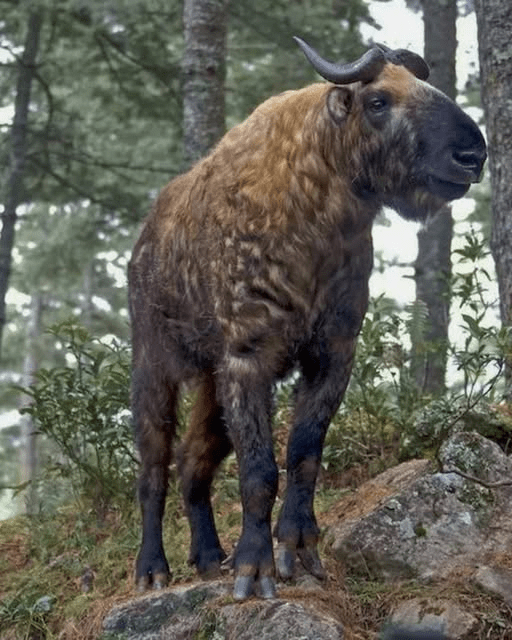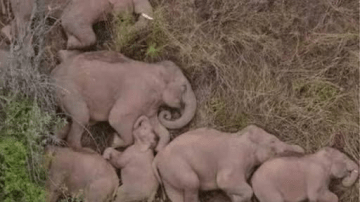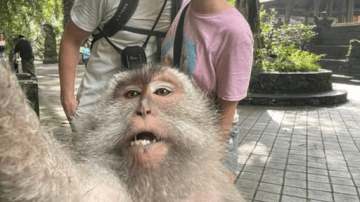High in the mist-covered slopes of the eastern Himalayas, where the air is thin and the world feels untouched by time, lives a creature so rare and mysterious that even seasoned explorers pause in awe when they glimpse it. With its powerful body, shaggy golden fur, and strange, almost mythical appearance, the Takin looks like something born from legend—a cross between a goat, a musk ox, and perhaps even a creature from an ancient Himalayan tale.

Locals call it Dong Gyem Tsey in Bhutan or Gnu Goat in parts of China. But around the world, it’s simply known as the Takin—a majestic symbol of endurance, adaptability, and the wild beauty of the high mountains.
The Enigmatic Beast of the Clouds
The Takin is not an animal you’re likely to encounter on a casual trek. These elusive mammals live in small herds above 4,000 meters (13,000 feet), navigating some of the steepest and most dangerous terrain on Earth. Their thick coats shimmer gold and bronze in the sun, perfectly blending into the misty, rocky landscapes of the Himalayas.
At first glance, a Takin looks almost mythical. Its massive head, arched nose, and deep-set eyes give it an almost regal appearance. Its neck is thick and powerful, supported by short but muscular legs built for climbing the near-vertical cliffs of Bhutan, Tibet, and northern Myanmar. Males can weigh more than 200 kilograms (441 pounds), their hooves gripping the icy rock with effortless precision.
And yet, despite their imposing build, Takins move with surprising grace—quiet, sure-footed, and completely at home among the clouds.
A Creature Perfectly Designed for Survival
Nature designed the Takin for the extremes. Winters in the Himalayas can bring temperatures well below freezing, yet this animal thrives where few others dare to live.
Its woolly, oil-coated fur acts like a natural waterproof blanket, repelling rain and snow. Beneath the fur, thick layers of fat insulate its body against the cold. When blizzards sweep across the slopes, Takins huddle together for warmth, their combined body heat keeping the herd alive through the harshest nights.
But perhaps the most fascinating thing about the Takin’s adaptation lies in its scent. Scientists believe the oily secretion from its skin not only waterproofs its fur but also helps it blend into the environment by masking its scent from predators like snow leopards and wolves.
| Takin Feature | Purpose | Survival Advantage |
|---|---|---|
| Thick, oily coat | Insulation and waterproofing | Protects from cold and snow |
| Short, strong legs | Climbing steep cliffs | Access to food and safety |
| Large, arched nose | Warming cold air before it reaches the lungs | Prevents frostbite in freezing air |
| Group living | Shared warmth and protection | Increases survival during harsh winters |
Life at the Roof of the World
Takins are social animals. They live in groups that can range from small family herds to massive gatherings of over a hundred individuals during the summer months. In spring, when snow begins to melt, they descend slightly to feast on the fresh shoots of bamboo, rhododendron leaves, and other alpine plants.
Their diet might seem modest, but it’s perfectly suited to their environment. Bamboo, though tough and fibrous, provides essential nutrients and moisture. Takins also eat leaves, grasses, and even salty mineral deposits found on rocks—nature’s way of balancing their diet.
When the first snows return, they climb back up the mountains, where predators are fewer and the air is thin enough to discourage human intrusion. Their thick necks and muscular legs make the climb effortless, and their hooves are uniquely adapted to grip even slippery stone.
At dawn and dusk, their silhouettes can sometimes be seen moving like golden shadows across the cliffs, disappearing just as quickly into the fog.
The Mystery of Their Origins
For centuries, the Takin puzzled naturalists. Was it related to goats? Sheep? Cows? Its appearance seemed to borrow a bit from each. Modern genetics has finally solved part of the mystery—Takins belong to the bovid family, making them distant cousins of musk oxen and goats.
But the truth is, there’s no other animal quite like it. Even Charles Darwin himself would have marveled at the way the Takin represents evolution’s creativity—a perfect example of adaptation and survival.
Its broad nose, for instance, is thought to help warm the frigid air before it reaches the lungs—a feature shared with Arctic animals like reindeer. Its thick fur mirrors that of mountain yaks, while its social behavior resembles that of wild sheep.
Some say the Takin’s appearance even inspired legends of the golden fleece or the Chinese unicorn, and it’s easy to see why. Standing proud against the snowy peaks, the creature radiates an almost mythical aura—part beast, part guardian of the mountains.
A National Treasure and a Symbol of Strength
In Bhutan, the Takin holds a special place in national identity. It’s the national animal, chosen not only for its rarity but for its deep connection to Bhutanese mythology.
According to legend, a Tibetan saint named Drukpa Kunley, known as the “Divine Madman,” was once asked by villagers to perform a miracle. In response, he attached a goat’s head to a cow’s body, clapped his hands, and brought the strange creature to life. Thus, the Takin was born.
Today, this legend is celebrated as a symbol of balance between humor and holiness, strength and humility. Bhutan even has a Takin reserve near Thimphu, where visitors can observe these gentle giants in their natural environment.
A Species on the Edge
Despite their strength and adaptability, Takins face growing threats. Habitat loss, climate change, and poaching have taken a heavy toll on their numbers. Deforestation pushes them higher into the mountains, where food is scarce. Meanwhile, illegal hunting for meat and horns continues in remote regions.
Conservation efforts are underway in China, Bhutan, and India to protect these remarkable creatures. Sanctuaries, anti-poaching patrols, and community education programs are slowly making a difference. In Bhutan, for instance, the population has stabilized, thanks to strict protection laws and respect for wildlife.
But in the grand scale of the Himalayas, every Takin sighting remains a treasure—proof that ancient life still thrives in the modern world.
| Region | Population Trend | Main Threats | Conservation Status |
|---|---|---|---|
| Bhutan | Stable | Habitat loss | Protected |
| China | Decreasing | Poaching, deforestation | Vulnerable |
| India | Fluctuating | Human encroachment | Near Threatened |
The Soul of the Mountains
Standing on a ridge at dawn, you might see a herd of Takins moving slowly across the slopes, their golden fur glowing in the rising sun. They pause occasionally, lifting their heads as if to listen to the mountain’s heartbeat.
There’s something profoundly peaceful about them—something ancient. In their steady gaze, you glimpse 4,000 years of endurance, wisdom, and quiet strength.
To watch a Takin in its natural habitat is to witness the living memory of the Himalayas. These creatures are not just survivors—they are symbols of resilience, reminders that balance with nature is still possible, even in the harshest environments.
Final Thought
The Takin may not roar like a tiger or soar like an eagle, but its story is one of quiet power—a life carved from rock, snow, and endurance. In every sense, it embodies the spirit of the Himalayas: strong, mysterious, and unyielding.
So the next time you look up at the distant mountains, imagine them not as empty peaks but as living kingdoms—where golden-coated Takins still roam above the clouds, guardians of a world we’re only beginning to understand.
This article celebrates the Takin as a rare and majestic symbol of the eastern Himalayas, reminding us that even in the remotest corners of Earth, life finds a way to thrive when respect and harmony prevail.





